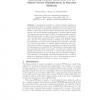184 search results - page 11 / 37 » Using FPGAs to solve the Hamiltonian cycle problem |
108
click to vote
ERSA
2010
14 years 9 months ago
2010
Cache-based, general purpose CPUs perform at a small fraction of their maximum floating point performance when executing memory-intensive simulations, such as those required for sp...
113
Voted
AMC
2006
14 years 11 months ago
2006
-- Tien D. Kieu, in 10 papers posted to the quant-ph section of the xxx.lanl.gov preprint archive [some of which were also published in printed journals such as Proc. Royal Soc. A ...
108
Voted
FPGA
2005
ACM
15 years 5 months ago
2005
ACM
Floating-point Sparse Matrix-Vector Multiplication (SpMXV) is a key computational kernel in scientific and engineering applications. The poor data locality of sparse matrices sig...
138
click to vote
ARC
2010
Springer
15 years 6 months ago
2010
Springer
Computing the solution to a system of linear equations is a fundamental problem in scientific computing, and its acceleration has drawn wide interest in the FPGA community [1–3]...
101
click to vote
COMBINATORICS
2002
14 years 11 months ago
2002
The directed anti-Oberwolfach problem asks for a 2-factorization (each factor has in-degree 1 and out-degree 1 for a total degree of two) of K2n+1, not with consistent cycle compo...


